A return to "Arrival"
« previous post | next post »
It's been six years since the movie Arrival arrived in theaters and immediately attracted buzz here on Language Log and elsewhere in the linguaverse. The protagonist Dr. Louise Banks (played by Amy Adams) is a field linguist called upon to communicate with aliens, and the filmmakers took efforts to make that portrayal mirror Dr. Banks' real-life scholarly counterparts. Now comes a new "official retrospective companion book" about the film's creative process called The Art and Science of Arrival by Tanya Lapointe. And it has a section on how linguists reacted to Arrival — including quotes from a couple of Language Log posts.
In the "Fact vs. Fiction" section of the "Xenolinguistics" chapter (beginning on p. 124, as seen in the Google Books preview), Luke Lindemann is quoted as saying, "Arrival has fostered a lot of interesting conversations at the Yale Linguistics Department over the past few years." Lapointe explains, "I reached out to Luke because in 2016 the then PhD student in linguistics published a guest post on the Language Log website called "Will 'Arrival' bring linguistics into the popular consciousness?"
The book goes on to quote Luke's guest post:
Linguistics is a discipline that is seldom represented in popular media, and this is the first science fiction film I have seen that puts a great effort into representing a detailed scientific approach to an alien encounter. With a few caveats, linguists and linguistics were portrayed in a very true-to-life manner.
Some of Luke's more critical assessments are also noted, and Lapointe adds, "Below his article, a chain of comments reveals linguistic debates on various aspects of the film." (Hurray for Language Log commenters!)
"This kind of scrutiny from scientists is one of the reasons [production designer] Patrice Vermette was adamant about every detail in the film being as true to reality as possible," Lapointe writes. Even before Arrival premiered, we saw glimpses of this cinematic legwork in trailers and publicity stills featuring Louise's office and workspace, as I discussed in the post, "The making of a cinematic linguist's office" (10/21/2016). As it turned out, many of these details were based on consulting with linguists at McGill University, namely Jessica Coon, Lisa deMena Travis, and Morgan Sonderegger. The books filling Louise's office shelves (which I zoomed in on in my post) were mostly taken from Jessica and Lisa's offices.
The Art and Science of Arrival includes a photo of "a chalkboard illustrating the monolingual discovery procedure featured in Louise Banks' office," according to the caption. The "monolingual discovery procedure" is actually a phrase describing Louise's work from Ted Chiang's novella "Story of Your Life," which screenwriter Eric Heisserer adapted into the screenplay for Arrival. On Facebook, Jessica Coon posted a shot of the photo after receiving her copy of the book and said the set-design crew asked her to draw on the chalkboard, with instructions along the lines of "Just make it look like a linguist's chalkboard." Rather than the fictitious "monolingual discovery procedure," what she actually scribbled was an analysis based on her 2014 article with Pedro Mateo Pedro and Omer Preminger in the journal Linguistic Variation, "The Role of Case in A-Bar Extraction Asymmetries: Evidence from Mayan." (It even says "Coon, Mateo Pedro, & Preminger 2014 L.V." in the bottom right.) It's too bad we didn't get a good look at the chalkboard in the movie, but I'm glad the companion book now features it so prominently.
Another photo in the book shows conference lanyards hanging in front of a bookshelf. That's a nice true-to-life touch! One of the conference tags is from "Advanced Study in Applied Linguistics," and another is from "ALSS Conference, Boston 2014." We can assume the latter is based on the Linguistic Society of America's annual conference, which was indeed held in Boston in 2014. [Update: And as Kai von Fintel points out in the comments, the name-tags reveal Louise's previously undisclosed affiliation with MIT.]
Finally, the "Fact vs. Fiction" section quotes my post on Louise's office, where I wrote, "It's fair to say that it's the most meticulous rendering of a linguist's scholarly abode since the phonetician Peter Ladefoged helped design the lab of Henry Higgins in 'My Fair Lady.'"
In the post, I noted there was a ruler on Louise's desk, "not necessarily a common accoutrement in a linguist's office these days." The book goes into more detail about that ruler, with Jessica Coon recalling how she took the set designers up to Lisa Travis's office at McGill, where they took note of the items on her desk. Jessica is quoted as saying, "When somebody made a comment about the ruler, Lisa took a picture of the one on her desk and defended the film, explaining she uses a ruler to tear paper in straight lines." Lisa actually sent me a photo of the ruler on her desk at the time — here's a comparison between her ruler and Louise's in the movie.
I'm glad that, six years later, the mystery of Louise's ruler is fully resolved for all to see!
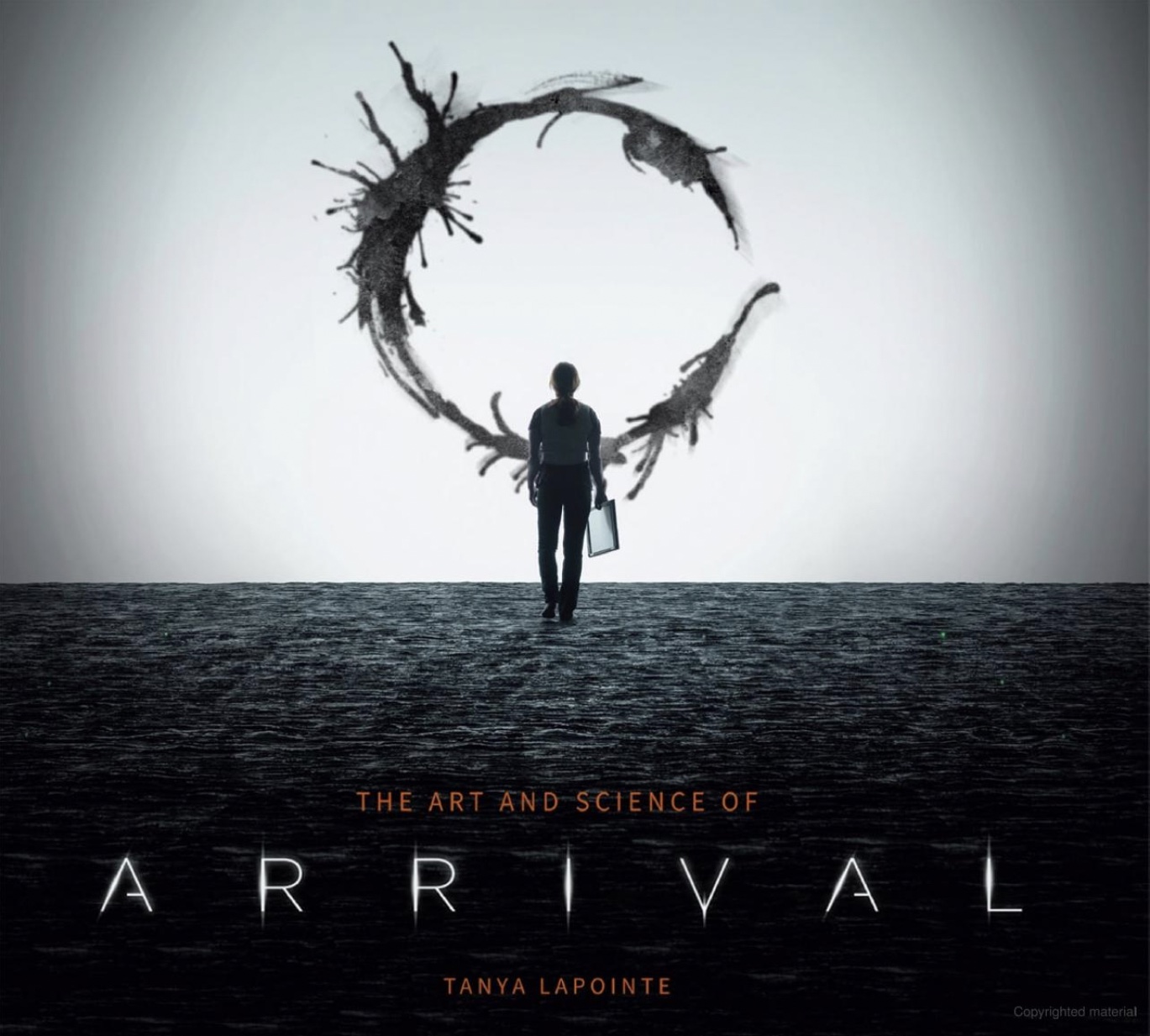
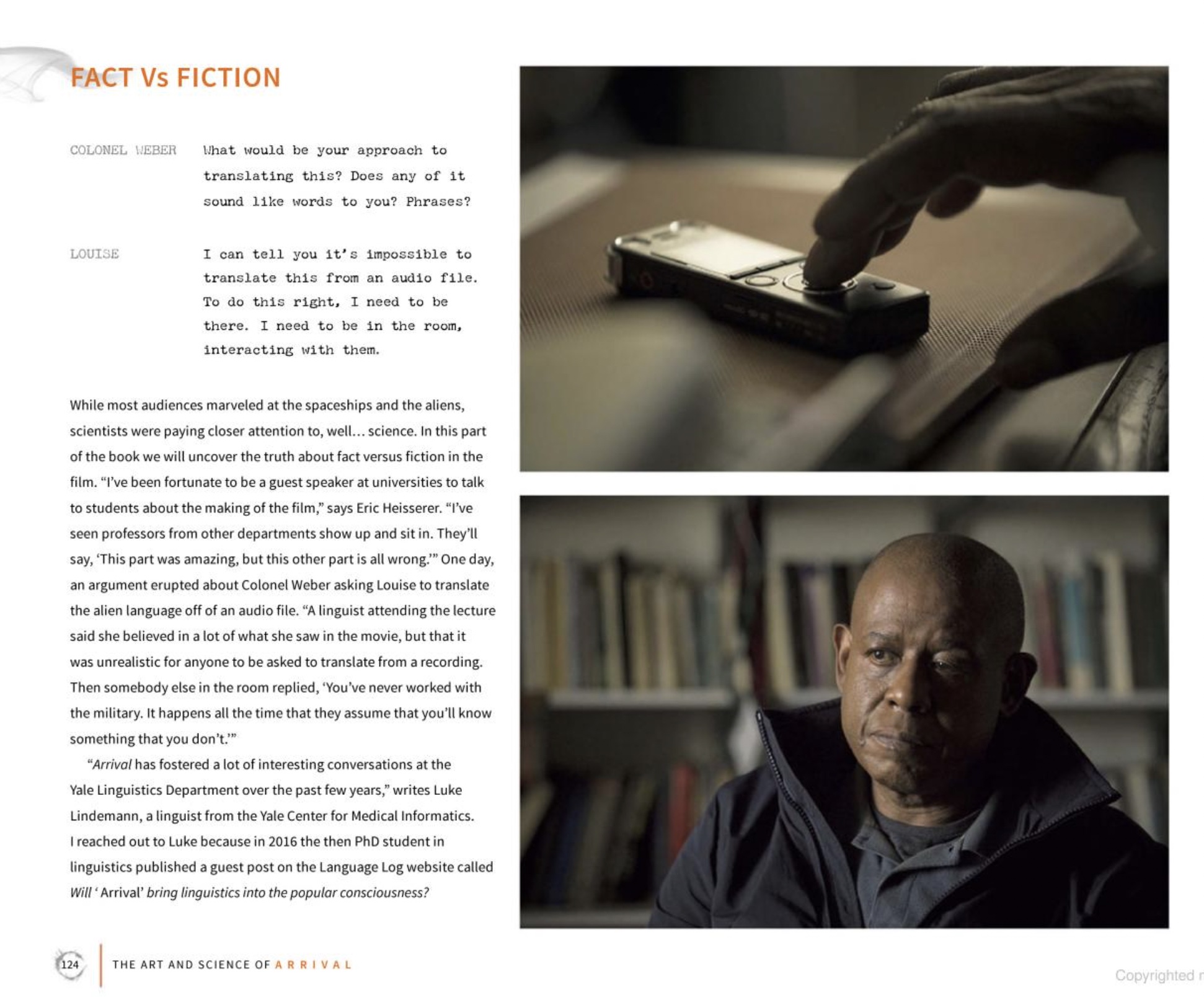

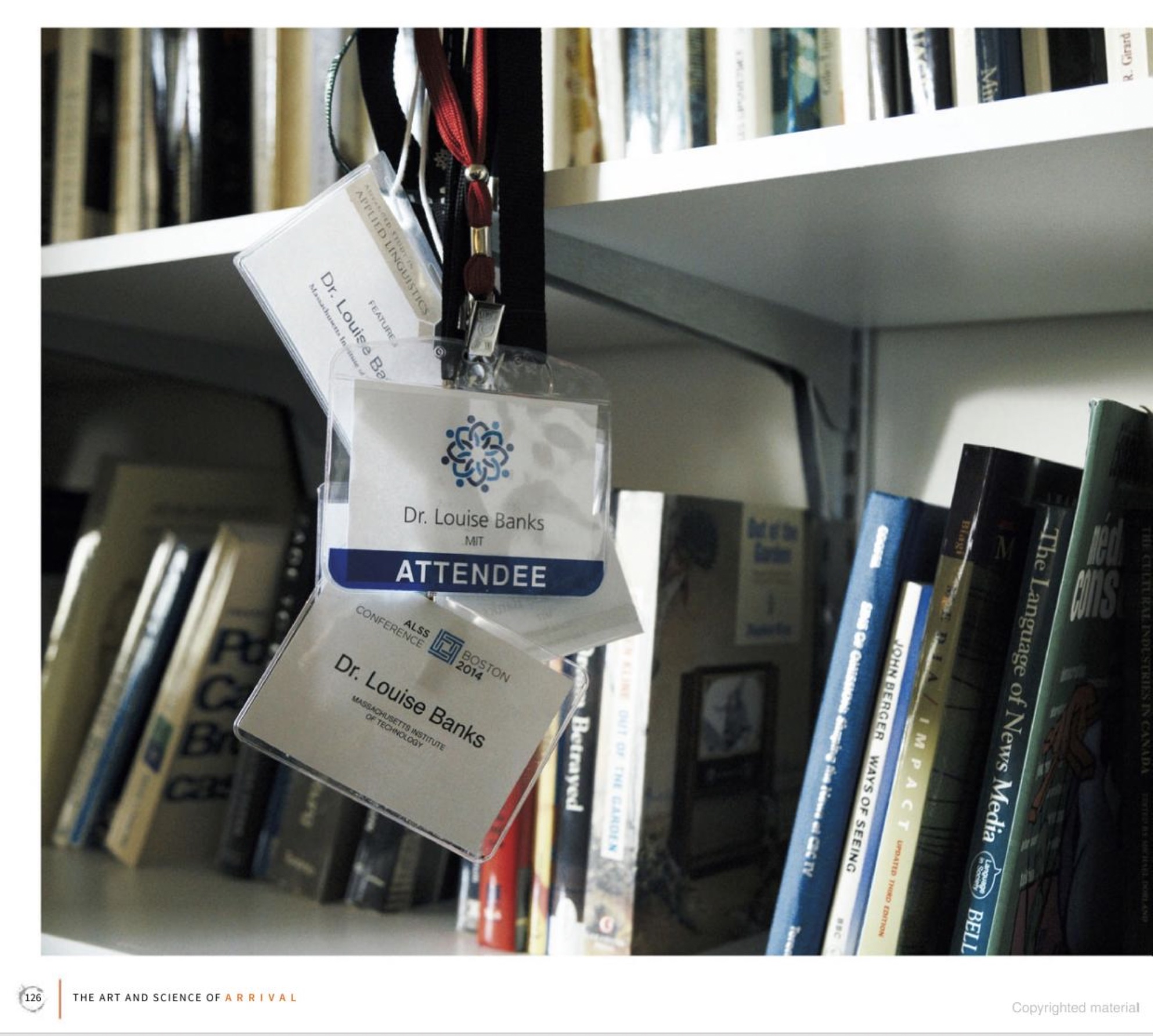
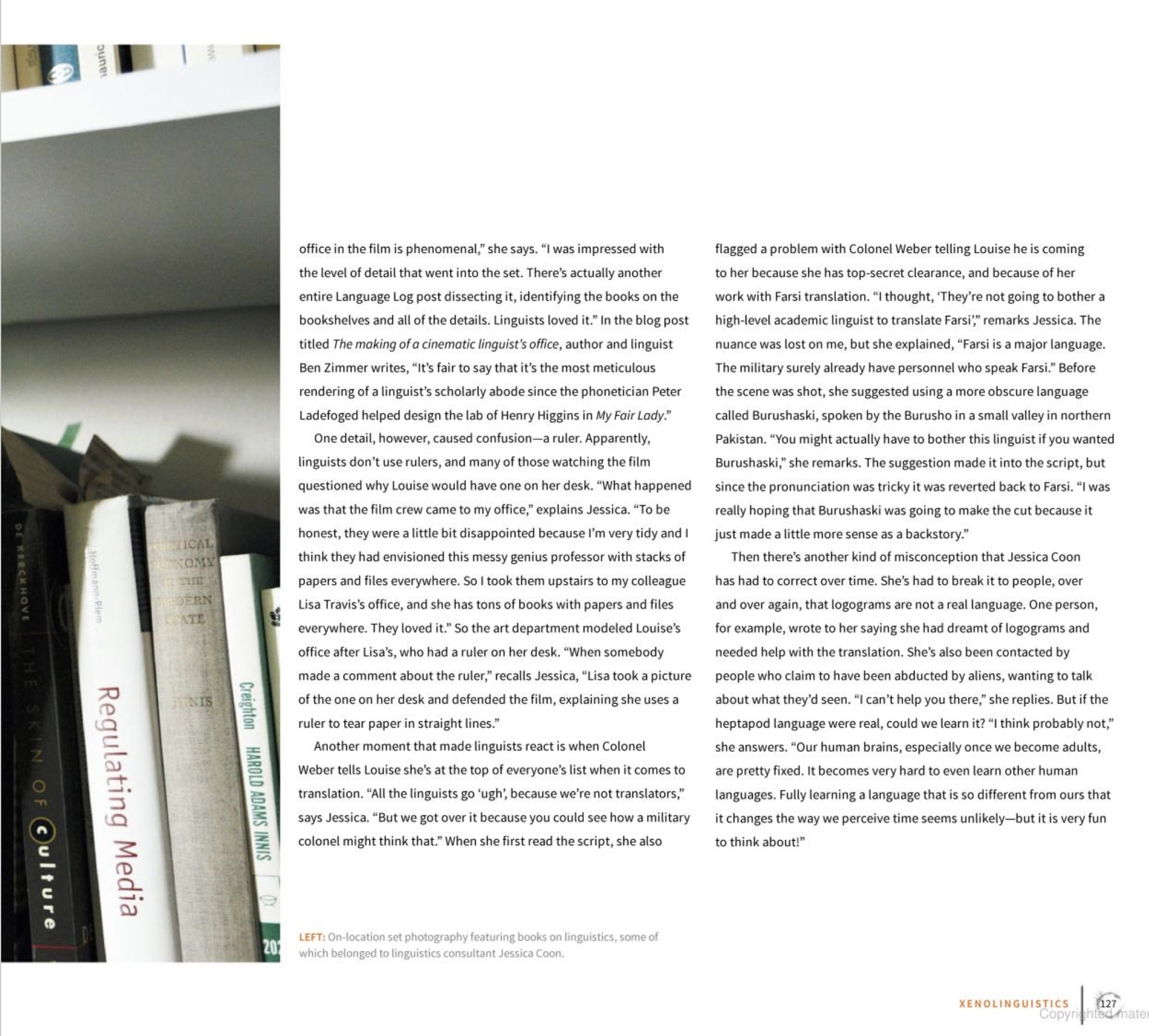

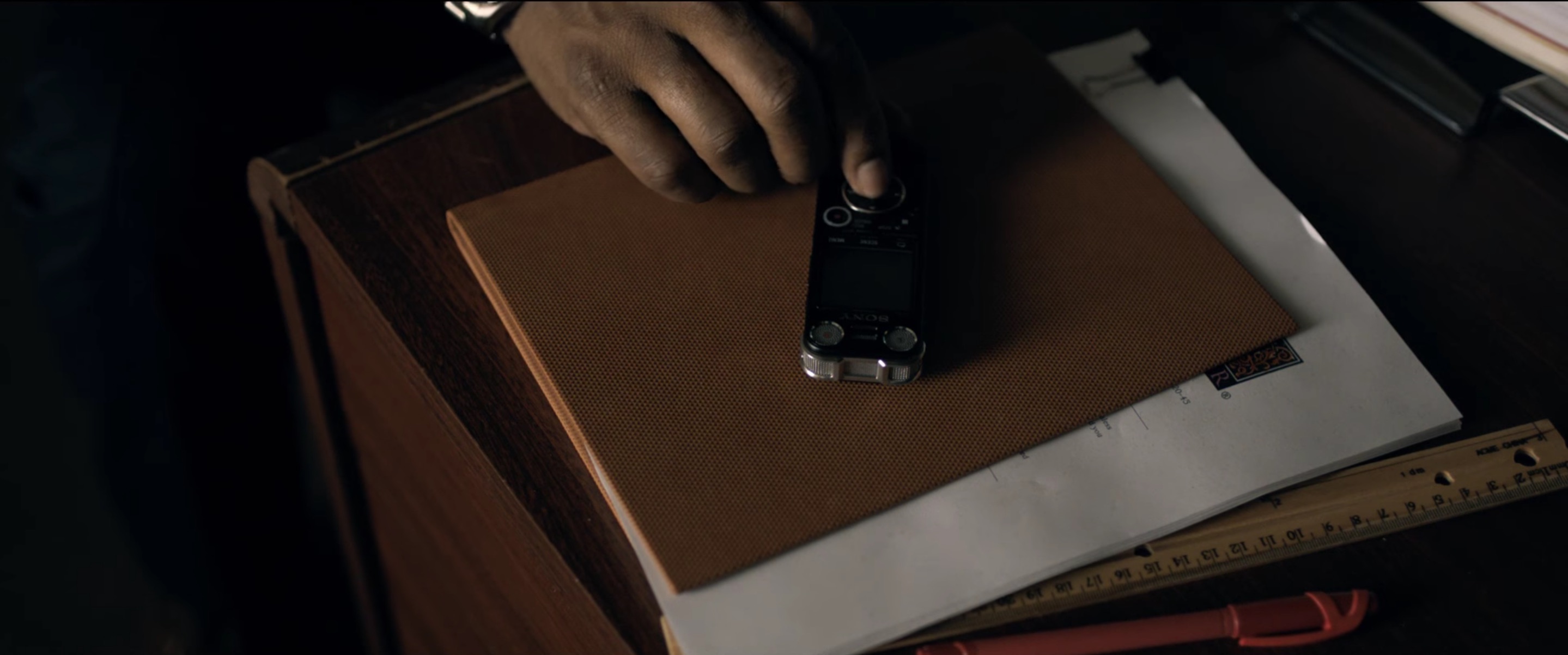
AntC said,
September 16, 2022 @ 2:41 am
(Thanks Ben)
the mystery of Louise's ruler
is only deepened. I can see that _if_ you're tearing paper, a linguist would want straight lines — to write language segments in linear script(?). (á la Wittgenstein) But then what? Is there a magnetic whiteboard with buttons to hold the Zettel? There surely wouldn't be enough desk space in a typical academic's office to lay them out — and anyway they'd get blown out of position.
Does Louise not use those pre-cut PVC strips that can be written on with marker pen and later erased? Available by the metre at prices even a cash-strapped Linguistics Department could afford; reusable/no more tedious tearing.
The book's set in 1998 — I assume the movie also (I haven't seen it). Magnetic whiteboards have been around since the 1970's. (They're in all the Police procedurals.)
Kai von Fintel said,
September 16, 2022 @ 7:08 am
From the close-up of the name tags, it appears that Dr. Banks works at MIT. I don't think I knew that.
Ben Zimmer said,
September 16, 2022 @ 8:14 am
@AntC: I believe the film, like the novella, is just supposed to be understood as set in "present-day" (not accounting for, um, temporal shenanigans). So that might have been 1998 for Chiang, but the film has the look of the mid-teens (right down to the 2014 conference nametags).
Mark Liberman said,
September 16, 2022 @ 9:29 am
By coincidence, Wednesday was "Biological Perspective" day in ling0001, and I used a set of lecture slides that I originally put together for the course in 2015, following a journalist's question:

You can check out slides 3-6 for my answer.
(By the way, the new name "ling0001" results from Penn's strange decision to expand all course numbers by one digit, and doesn't imply that there are (in reality or even potentially) 10,000 linguistics courses…)
Victor Mair said,
September 16, 2022 @ 11:10 am
"Another photo in the book shows conference lanyards hanging in front of a bookshelf."
That touch seemed very familiar.
In a corner of my office next to my desk, there hangs a tangle of conference lanyards about four feet long. It abruptly stopped growing in March, 2020, when I was scheduled to fly to Boston for a conference.
Don said,
September 16, 2022 @ 6:12 pm
Do you think Arrival can be considered a “ball of wheat”?
Madhuri Kherde said,
September 17, 2022 @ 5:14 am
Science fiction films created with great efforts are helpful to know the term well with entertainment. In addition, communication with aliens has a curiosity in people's minds. Nice job!
David Morris said,
September 17, 2022 @ 5:51 am
I (now working as a legal editor) have a ruler on my desk, left by the previous occupant.
RP said,
September 18, 2022 @ 3:00 am
@Mark Lieberman. Thanks for posting the slides on Communicating with Aliens.
That reflects very much the problem I had with Arrival, even without your expertise. They gradually learned the alien language word by word, which made no sense to me. If I remember rightly, they start with the names of the people/aliens present during the interaction and then we skip to cue cards for words they supposedly know in Alien, with all kinds of abstract concepts, verbs etc. How could you get from 'Louise' to 'Louise runs' with a bunch of aliens floating in a tank?
I do not think it could possibly work that way, and in fact a radical misunderstanding of language acquisition. Did Wittgenstein count for nothing?!
mg said,
September 18, 2022 @ 12:31 pm
Having a ruler in easy reach is very important for those of us whose backs get itchy at inconvenient times.
V said,
September 20, 2022 @ 2:09 pm
I actually did not like the film adaptation, unlike the short story. The film skipped over some important points.